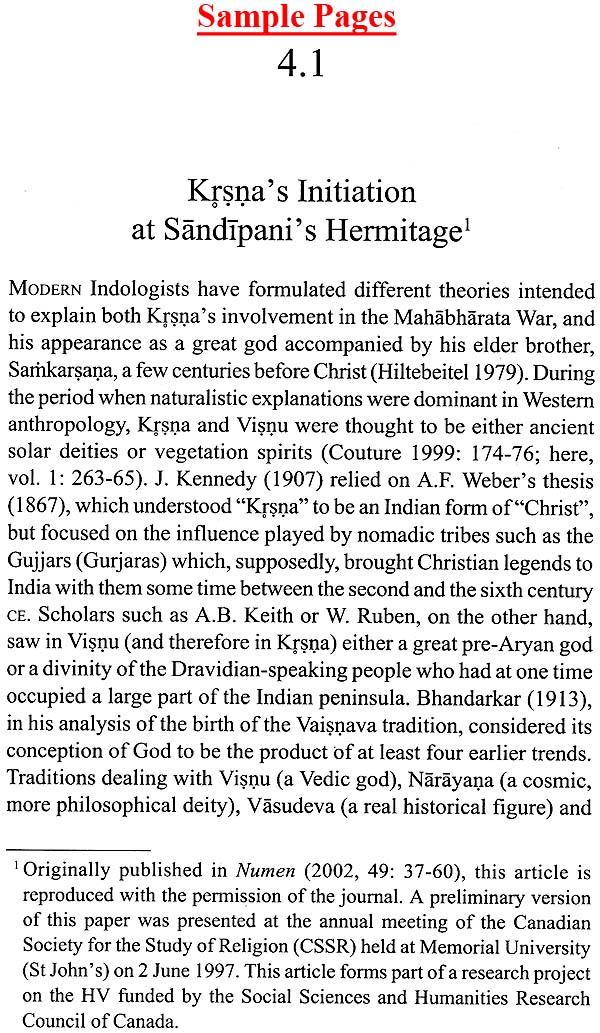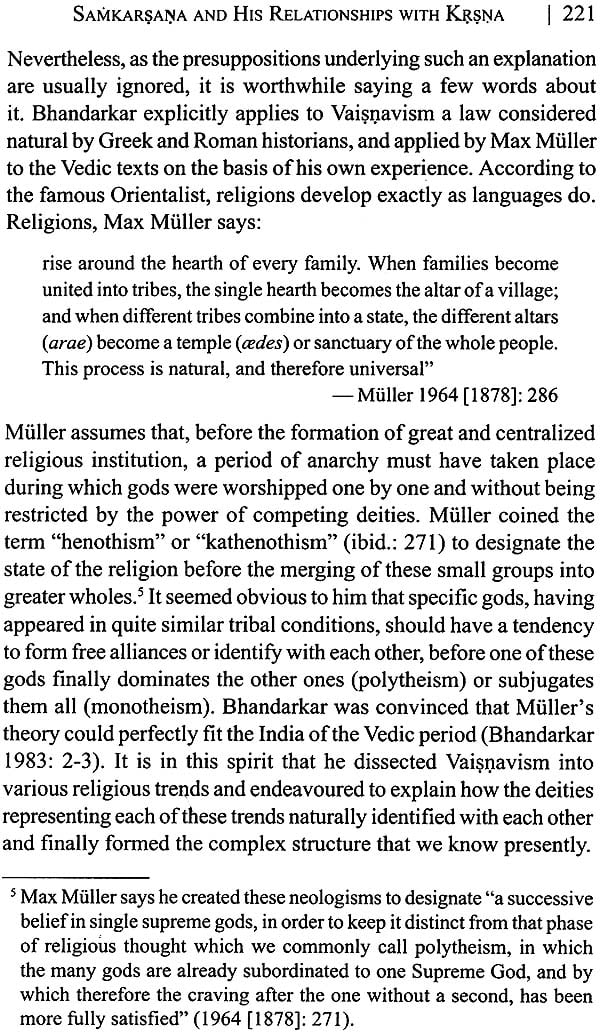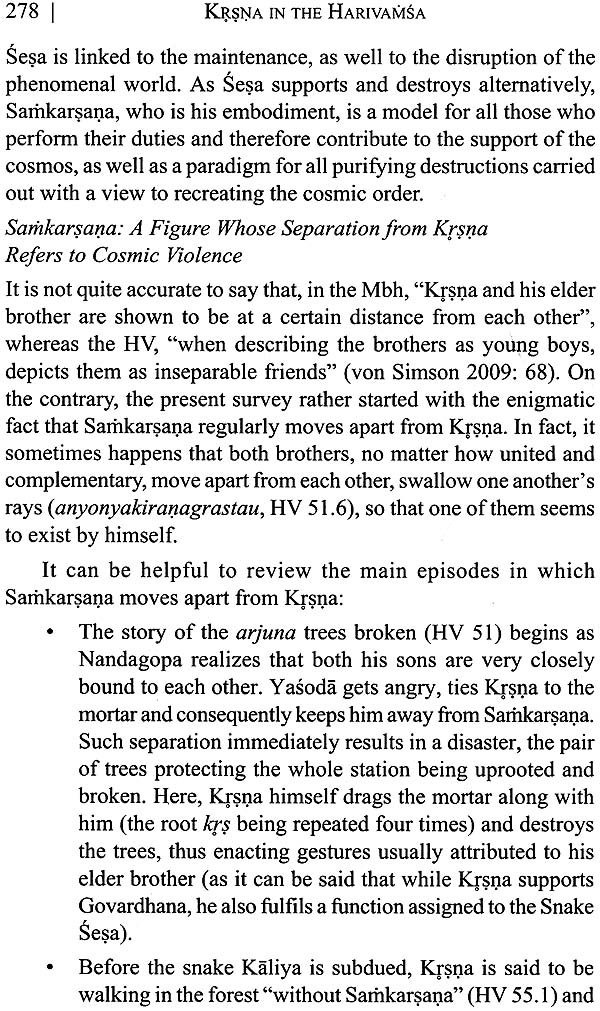
| Item Code: | NAN778 |
| Publisher: | D. K. Printworld Pvt. Ltd. |
| Author: | Andre Couture |
| Language: | English |
| Edition: | 2017 |
| ISBN: | 9788124608913 |
| Pages: | 520 |
| Cover: | Hardcover |
| Other Details | 9.0 inch x 6.0 inch |
| Weight | 870 gm |
This second volume of Krsna in the Harivamsa brings together texts written between 2000 and 2015, more than half of which are of more recent vintage than those included in Volume I. While Krsna's biography is clearly divided into two large units, childhood and adulthood - the ksatriya (warrior) of the second period manifesting himself first as a gopa (cowherd) - it is important to note that both sections of the biography are similarly structured and carry an identical message. This book contends that the child and adult Krsnas are indeed one and the same.
The initiation by Guru Kasya Sandipani, the construction of the city of Dvaraka, and the fights involving Pradyumna and Aniruddha are among the best known episodes analysed in this volume. It is the oft-neglected Harivamsa version of these well-known stories that is studied here, version that has been passed over despite its early date of composition.
An unstated assumption still influences a great deal of Harivamsa research. Many scholars assume that an addition of this sort to the Mahabharata can be little more than a collection of ancient records bearing witness to the primitive mentality of a people unable to think logically. On this view, the Harivamsa becomes reduced to a pile of documents of diverse origins. The articles contained in this volume take the opposite view. Krsna's biography, which at first blush might appear to be an amalgam of various stories, proves in fact to be a skilful construction which conveys a clear message.
Andre Couture, now affiliate professor at the Faculte de theologie et de sciences religieuses, Universite Laval, Quebec, Canada, recently retired from his position there as full professor in the field of Indology. Couture has published on a wide variety of topics. Of special interest in this context are a number of articles on Krsna mythology and the translation of a number of texts including: chapters 30-78 of the Harivamsa (L'enfance de Krishna, 1991); Appendix I, no. 41, of the Harivamsa (La vision de Markandeya et la manifestation du Lotus, 2007); Bhasa's Balacarita (in Theatre de l'Inde ancienne, ed. Lyne Bansat-Boudon, 2006); and with Christine Chojnacki, Hindu, Buddhist and Jaina texts related to the Harivamsa (Krishna et ses metamorphoses dans les traditions indiennes. Recited enfance autour du Harivamsha, PUPS, 2014).
VOLUME 2 brings together texts written between 2000 and 2015, more than half of which are of more recent vintage than those included in vol. 1. Its title, The Greatest of All Sovereigns and Masters, underscores the primary role played by Krsna in the stories told by the authors of the HV. By the end of the 1990s, after a period in which I had focused on Krsna's childhood, I began to take a more pointed interest in questions related to the adult Krsna. While it remains true that the HV has not received the scholarly attention it deserves, the sections dealing with the battles fought by Krsna as a ksatriya (chaps. 79-118) having been sorely neglected both by the Vaisnavas themselves and by scholars in general. A number of episodes found in the BhP have been the subject of analyses - the initiation with the Guru Kasya Sandipani, the construction of the city of Dvaraka, the fights involving Pradyumna and Aniruddha. However, the study of earlier versions of these same stories in the HV has largely been passed over.
The study of the narrative construction of Krsna's biography according to the HV, the ViP and the BhP, reveals the existence of two large units, childhood and adulthood. The ksatriya (warrior) of the second period manifests himself at first as a gopa (cowherd). Despite this obvious division, it is clear that we are not dealing here with two Krsnas. Indeed, both sections are similarly structured and carry an identical message. On the one hand, during his childhood, the young Krsna is living with his elder brother in a forest, sometimes called Mahavana, before they, along with cows and herders, are forced to leave for a second forest, the marvellous Vrndavana, where a new settlement is built. On the other hand, the grown-up Krsna, after some hotly contested battles against King Jarasandha, decides to abandon Mathura, moves west, where he builds a new city, the celebrated Dvaraka. Before he can take on this task, he has to fight the terrible Kalayavana. The basis for this parallelism seems to be the relationship of both series of episodes to the pralaya myth, that is, the destruction of a first world and the escape to a new ideal world (see Chap. 4.2). A second parallelism can be identified. In the forest surrounding Mathura, the young Krsna, with the help of his elder brother, fights against various incarnations of demons (Dhenuka, Pralamba, Arista, Kesin) sent by King Karnsa to the cow settlement to annihilate him. Through these victories, he wins the title of Gopala, that is, Pastor of the whole world. Similarly, all along the way from Mathura to the marvelled city of Dvaraka, Krsna fights the terrestrial kings Jarasandha, Kalayavana, Rukmin and Naraka. He even snaps a celestial tree from Indra's paradise. Krsna's sovereignty over heaven and earth are thus symbolically expressed through the conquest of the directional points (digvijaya) and through the marriages with numerous princesses that follow.
Volume 1 demonstrates that the Krsna stories encourage reflection on the nature of the divine: Krsna who generates packs of wolves from the hairs of his body is a manifestation of a terrible form of deity; the one who dives into a large pool in the Yamuna river in order to subdue snake Kaliya imitates Visnu who descends into the human world; and the one who holds up Mount Govardhana acts as a new Brahma, able to create a new world. The adult Krsna can also be terrible when he destroys Kalayavana, and conquers Sonitapura, the city of Bana, which enjoys Rudra's protection. All around Dvaraka, he recreates a universal kingdom which includes every corner 'of India and even Indra's paradise. He is also able to manifest himself in order to safeguard the distressed women imprisoned by King Naraka. To facilitate Samkarsana's and Krsna's births, the presence of the Goddess Ekanarnsa is indispensable. She is a manifestation of Nidra or Yoganidra, Visnu's eternal spouse. She springs forth from Visnu's body, ever obedient to Visnu's orders (HV 48.10). The same goddess appears in the assembly hall of Dvaraka standing between Samkarsana and Krsna. She is also present in the stories of Pradyumna and Aniruddha where she is known as Maya or Kotavi.
There is an unstated assumption that still influences a great deal of HV research. Many scholars assume that a complement to the Mbh of this sort is no more than a collection of ancient records bearing witness to the primitive mentality of a people unable to think logically. The HV is thus reduced to a pile of documents of diverse origins. This series of articles takes, as you might already suspect, the opposite view. Appearing externally as an amalgam of various stories, Krsna's .biography is in fact a skilful construction conveying a clear message.
The first section of this volume (Vol. 2, part 4) contains four texts dealing with issues linked, either directly or indirectly, to the construction of the new city of Dvaraka. The first one (Chap. 4.1) is entitled "Krsna's Initiation at Sandipani's Hermitage". In HV 79 (as well as ViP 5.21, BrP 1.86, and BhP 10.45), Krsna's initiation takes place immediately after his killing Kamsa - an initiation which transforms the former child into an adult and which may be interpreted as the first step towards his triumph in Dvaraka. Occasionally mentioned in scholarly works, no attempt has yet been made to evaluate the significance of this event within the Krsna tradition. The chapter begins with a summary of HV 79, and then moves on to examine the character of Sandipani and his connection with Garga/Gargya, the brahmana who came to the settlement to perform the rites for the child's initiation. The episode provides a narrative link between the childhood period of both children and the rest of the story that deals with their adult lives as ksatriyas. As such, it helps clarify the overall structure of the HV.
The second paper, entitled "Dvaraka: The Making of a Sacred Place", addresses questions related to the construction of the new city. The city of Dvaraka is said to have been constructed according to the rules. In fact, a proper site had been chosen to build what is called a fortress on the sea; and Visvakarman, the architect of the gods, made the city as marvellous as the Amaravati of Indra. In addition to being a collection of the most precious things in the cosmos and an extension of Krsna's divine body, Dvaraka was expressly built using the ritual procedures for building a temple. The issues discussed include the ways found to deal with the lack of space needed for its construction, its link to the Goddess Ekanarnsa and to dharma, and the strange fact that this city was built only to be destroyed and abandoned.
| Abbreviations | vii | |
| Introduction | 1 | |
| 4.1 | Krsna's Initiation at Sandipani's Hermitage | 15 |
| 4.2 | Dvaraka: the Making of Sacred Place | 37 |
| 4.3 | Krsna's Second Enthronement at Kundina in the Harvamsa: the Study of a Late Episode | 65 |
| 4.4 | Krsna in the Harivamsa: A God Who Shares | 82 |
| 5.1 | Krsna, Samkarsana and the Goddess Ekanamasa in the Harivamsa | 113 |
| 5.2 | Krsna's victory over Bana and Goddess Kotavi's Manifestation in the Harivamsa | 133 |
| 5.3 | The Yawning of Divinities in the Mythology of the Epics and the Puranas | 167 |
| 5.4 | Noteworthy Resemblances Between Pradyumna's childhood and Krsna's childhood | 185 |
| 5.5 | the Emergence of a Group of Four Characters (Vasudeva, Samkarsana, Prayumna and Aniruddha) in the Harivamsa: Point for Consideration | 196 |
| 6.1 | Samkarasana and His Relationship with krsna: Prsence and absence, coming together and Moving Apart | 217 |
| 6.2 | Observations concerning the Notion of Bhakti in the Mahabharata | 293 |
| 6.3 | The Syamantaka Affair: A key Episode for the Interpretation of the Harivamsa | 337 |
| 6.4 | Krsna's victory over the Vedic Fires in the harivamsa | 384 |
| Conclusion: | ||
| From Visnu's Deeds to Visnu's Plays, or Observations on the Word Avatara as a Designation for the Manifestations of Visnu | 426 | |
| Bibliography | 446 | |
| General Index | 472 | |
| Index of Passages | 494 |
















Send as free online greeting card
